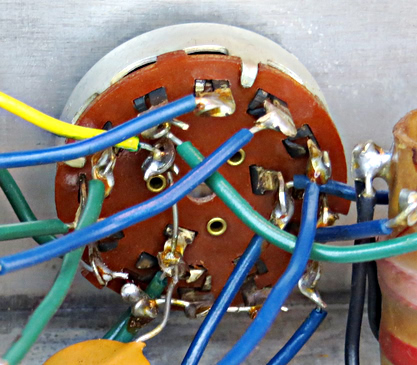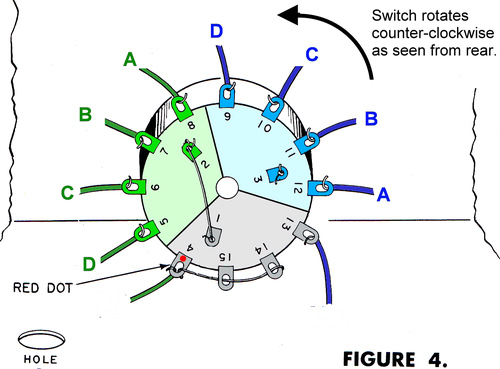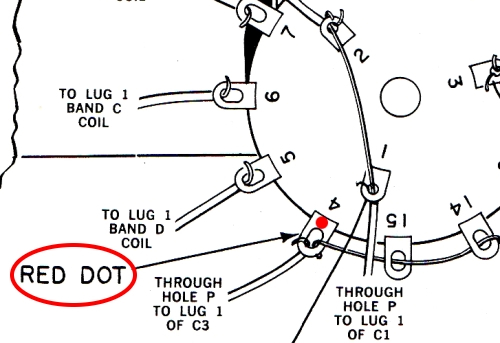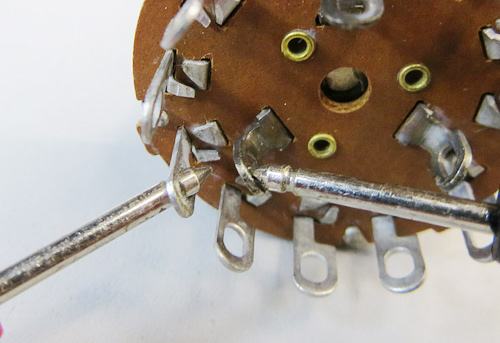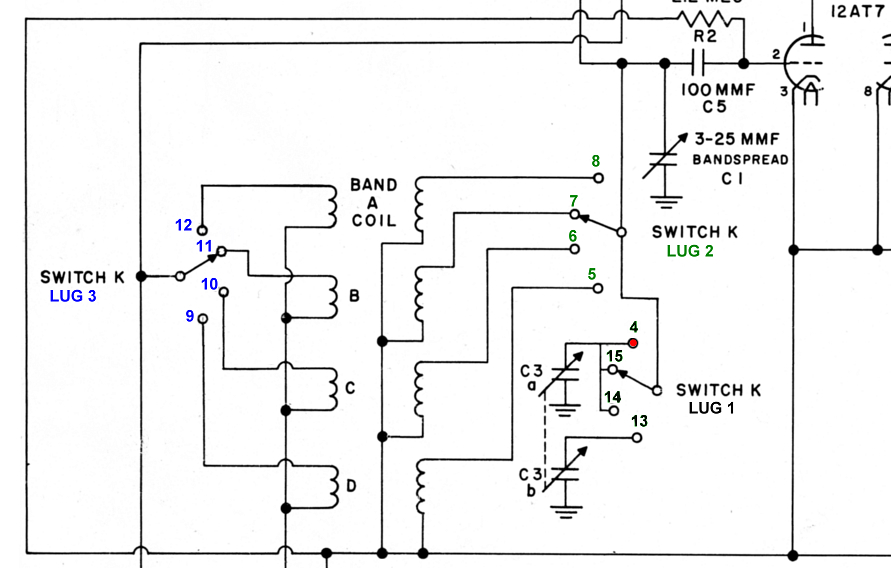 |
Lafayette KT-135 EXPLOR-AIR radio
kit |
 |
|
|
|
|
|
|
Click on photo for larger version. |
| This 1960 Lafayette catalog
page states "the chassis is
completely isolated from the circuit, so there is no
shock hazard." (Thanks to Jim Hale for catching this.) |
|
|
|
|
|
| This could be accomplished
if nylon screws and standoffs were used for the
tuning capacitors and a few extra wires were added,
which seems to be what they did. The green wire
shown above, connecting the two tuning capacitors
together, does not exist in any KT-135 I have ever
seen. |
|
|
|
|
|
In this rendering from the actual the construction manual, the wire
enters the hole in the chassis behind the 12AT7.
The frame of the main tuning capacitor is connected to the
chassis with metal standoffs and doesn't need the third
wire. |
|
|
|
|
|
|
|
Truth in advertising! How it appears in
the ad and how it would actually look.
Notice the radio is the white version shown on the previous
pages. |
|
|
|
|
|
|
|
|
|
Here's an ad from 1961. It, too, states
the chassis is completely isolated from the circuit. Click
on the ad for a larger version. |
|
|
|
|
|
|
|
|
| I replaced the cord on my
soldering iron with an old KT-135 cord after I
melted the old cord while not paying attention. |
|
|
|
|
THE SCHEMATIC |
|
|
|
|
| This is the
schematic diagram from the assembly manual. A schematic
doesn't normally represent how the parts are
physically assembled, but I was confused by some of
it. (Click on the diagram to open a larger version.) |
|
|
|
|
|
|
Let's see how these highlighted parts are rendered in the
schematic. |
|
|
|
|
|
|
|
R3 and C10 appear to be connected
to the 50C5 vacuum tube on the schematic, but they are physically
connected to lug 1 of the coil for band B, on the
opposite side of the radio!
The symbol with
the tapered horizontal lines designates that one side of R3
and C10 are connected to the chassis, ergo one side
is soldered to a lug that is
screwed to the chassis. They have nothing to do with
the 50C5 vacuum tube or the coil, it only appears that way at
first glance. |
|
|
|
|
|
|
As shown on the
previous page, R3 also has a connection to the AC plug.
This side of the plug is also B minus in the circuit. R3
and C10 connect the B minus to the chassis. This creates a
mild shock hazard, so they must be important. |
|
|
|
|
|
| The main tuning capacitor is
connected to the chassis with metal screws and
standoffs. R3 and C10 are
actually connected directly to the tuning capacitor with a
soldering lug to one of the screws that hold it to
the chassis! A terminal on the B coil is used to
pick up the B minus. |
|
|
|
|
|
| R3 and C10 are used to connect the tuning capacitor to B
minus by way of the metal chassis. They also isolate
the tuning capacitor and the chassis from the
110 volts AC. There was nothing "wrong" with
the original schematic, but now the components don't
appear to be part of the 50C5 hookup. |
|
|
|
|
|
|
|
|
On the left is
resistor R2 and capacitor C6 soldered to the bottom
of the 12AT7 tube socket. Look how they are drawn in
the schematic.
What the heck? I was stricken dumb with
bewilderment which bordered on stupification. |
|
|
|
|
|
Why wasn't it
drawn like this?
|
|
|
|
|
|
|
| This shows the regen control and the RF choke.
The schematic (left picture) has R8 connected to the
wrong terminal on the
regen control. |
|
|
|
|
|
|
Here the choke connections are flipped,
making the diagram much easier to follow. |
|
|
|
|
|
|
|
|
|
| The
corrected and rearranged schematic. (Click for larger
version) |
|
|
|
|
THE ROTARY SWITCH (SWITCH K) |
|
|
|
|
|
The rotary switch is a 3
pole, 4 position non-shorting type (3P4T). An exact
replacement was made by Mallory, part number 3234J. |
|
|
|
|
|
|
The wiring of the switch looks
confusing, but you can visualize it as three
separate switches that move in unison. Notice that lug 1 is tied
to lug 2. This connects the coils to the tuning
capacitor via lugs 4, 15, and 14, except that on Coil D, lug
13 connects to the smaller gang of the tuning
capacitor. |
|
|
|
The
red dot is important. If
you have replaced the switch you need to
know where to start wiring. The first
outer connection made to the switch as you're building
the radio is to lug 4. The instructions don't specify
how to mount the switch, but the drawings clearly
show a red dot.
If you have removed the
switch while rebuilding the radio and can't find the red dot, can
you trust the drawing? Yes! If you mount the switch
according to the drawing, lug 4 will be below and to
the left of lug 1.
If you're replacing the switch
with a different type, try this: Turn the switch
counter-clockwise as far as it will go. Select one
of the inner connectors on the back. This will be
lug 1. Use an ohm meter or some type of continuity
tester and find the outer lug that shows a
connection to lug 1. This will be lug 4. Mark it
with a red dot. The dot has to be red or the switch
won't work! (Not really.)
|
|
|
|
|
|
|
Here are the switch
designations on the schematic (since Lafayette
didn't add them). As far as the numbering system is
concerned, it seems the designer selected
lug 4 (with the red dot) and then went around the
switch clockwise. This put the numbers out of order
at Lug 1.
It didn't really matter. Not a
single person ever used the schematic to wire the switch. It is merely presented here
so you can bring it up on your phone at the start of
a party and break the ice. |
|
|
|
|
|
Next, some other Lafayette KT-135 kits restored or
refurbished.. |
| |
|
|
| |























